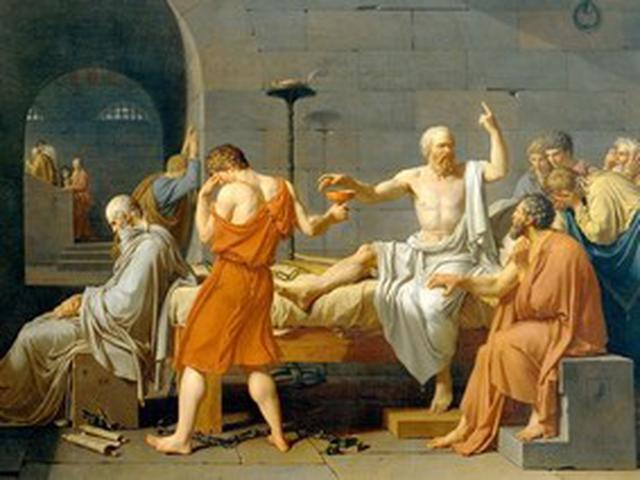The death of Socrates

The Death of Socrates by Jacques-Louis David depicts Socrates as the stoic old man in a white robe, sitting upright on a bed; His right hand extended over a cup, the left hand is gesturing in the air. He is surrounded by students and loyal followers showing emotional distress. The young man who hands him the glass looks away, with his face in his hand. Another young man grabs the old man's thigh, begging Socrates not to take the poison. An old man sits at the end of the bed, it is Plato, his most famous student, and he is seen slumped over and looking into his lap.
Socrates and Plato's teacher were unjustly convicted and sentenced to death for impiety and corruption of the youth of Athens. In his 1787 painting, The Death of Socrates, Jacques-Louis David attempts to capture the moment of Socrates' willing submission through the hemlock. Plato writes about Socrates' trial, imprisonment, and suicide in three works, Apology, Crito, and Faedo. David includes elements from all three plays in his interpretation of the death of Socrates and is therefore challenged to present the visually historical events and the philosophical dialogues surrounding them.
The author of this work Jacques-Louis David (1748 - 1825) was a French painter of the neoclassical style, considered the most outstanding painter of the time. In the 1780s, his history painting marked a change in flavor from Rococo frivolity toward classical austerity and sentiment, in harmony with the moral climate of the final years of the Royal Regime.
David became an active supporter of the French Revolution and friend of Maximilien Robespierre and was effectively a dictator of the arts in the French Republic. Imprisoned after Robespierre's fall from power, he aligned himself with another political regime after his release, that of Napoleon. At this time he developed his empire style. After Napoleon's fall from imperial power and the revival of the Bourbons, David went into exile in Brussels, then in the United Kingdom of the Netherlands, where he remained until his death.
© Tourblink